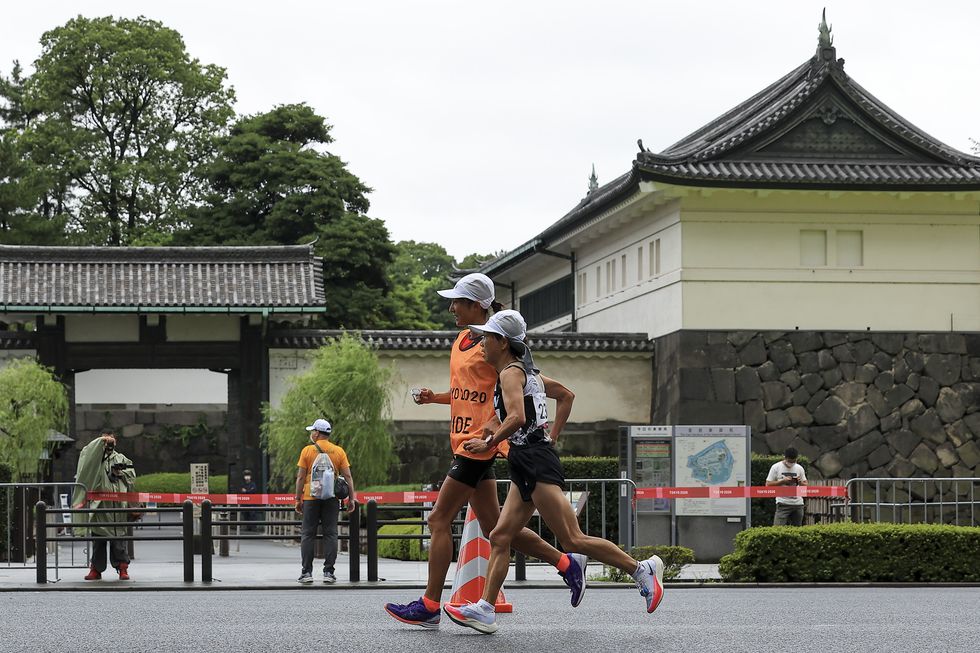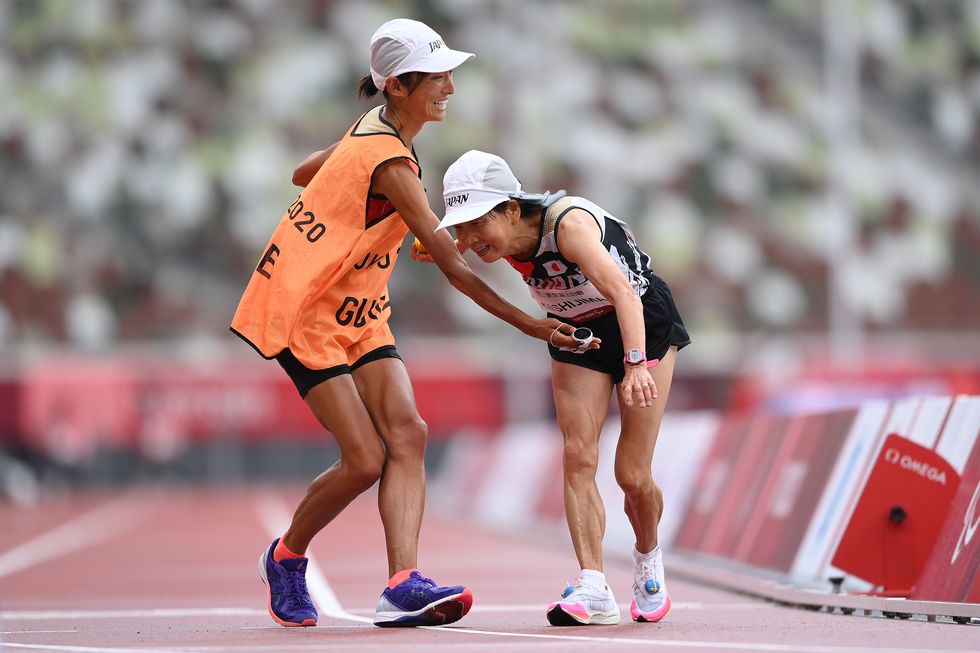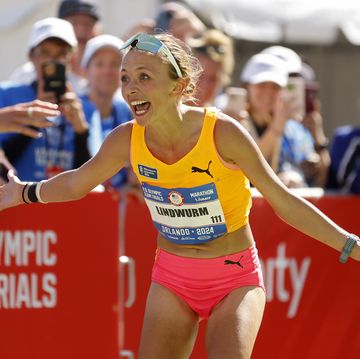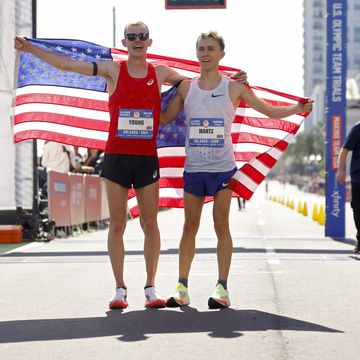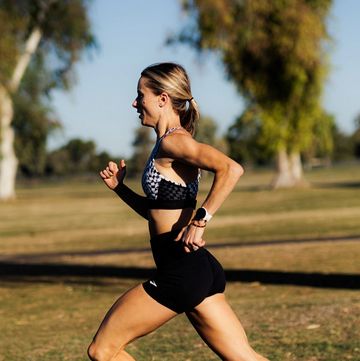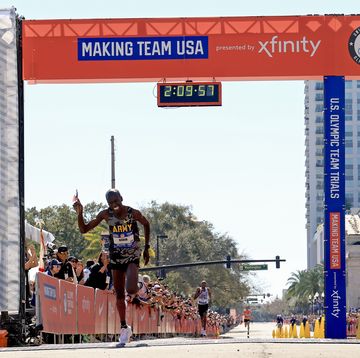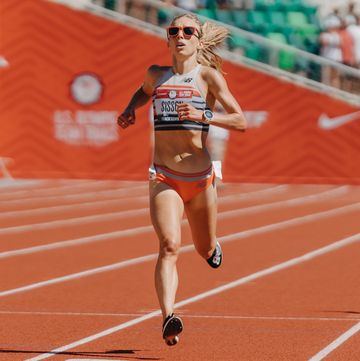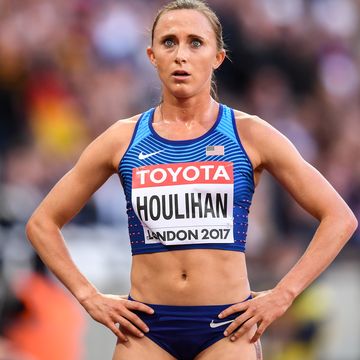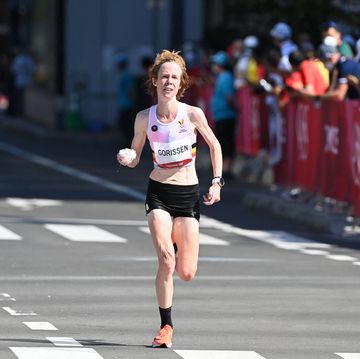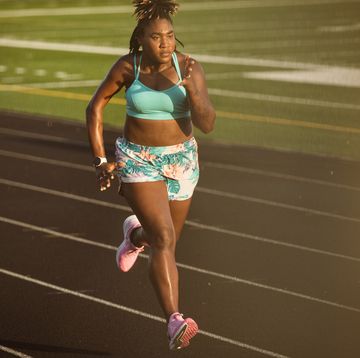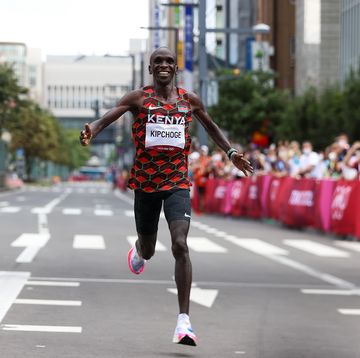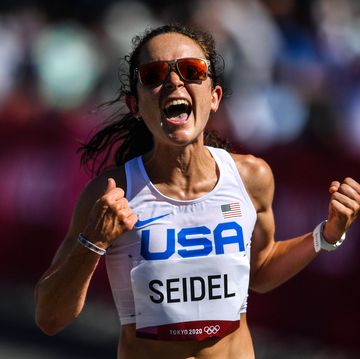If anyone had any doubts about the quality of competition at the Tokyo Paralympic Games, the T12 (for athletes with visual impairment) women’s marathon should have put those to rest.
The winner, Misato Michishita of Japan, ran 3:00:50. Elena Pautova of the Russian Paralympic Committee was second in 3:04:16. Louzanne Coetzee of South Africa rounded out the medals, finishing third in 3:11:13.
But the most dramatic finish of the day might have been Mihoko Nishijima, who staggered to an eighth-place finish in the category in 3:29:12, her guide smiling beside her as she crossed the line.
Oh, and one more thing: Nishijima is 66 years old.
Despite stopping and walking repeatedly—and nearly falling—in the final 5K, Nishijima’s time was enough to put her in the all-time world top-25 for the women’s 65–69 age group. She’s as taken aback by that as anyone.
“The last few years I’ve been the fastest woman my age in Japan, but I had no idea where that put me worldwide,” she said in an interview with Runner’s World, which has been translated from Japanese.
→ Sign up for Runner’s World+ to keep up with all of the latest pro racing news 🏅
A Midlife Pursuit
Visually impaired since birth, Nishijima works part-time as a massage therapist. Inspired by her husband, an avid amateur marathoner, she took up running mid-life.
“When I turned 40, I was really conscious that in terms of life being 80 years long, I’d rounded the turnaround point,” she said. “I wanted to find something I could enjoy, and when I looked at him, all the running friends he had and all his stories about things he’d seen and experienced while running, I thought, ‘Maybe I should try it too.’”
Despite only running for fun, Nishijima quickly progressed. In 2003, at age 47, she ran the elite Osaka International Women’s Marathon, where she set her lifetime best of 3:11:33. It was also the first time she ran with a guide, as her vision had worsened. Ever since, she has always had one.
The next decade went along the same way, working, running for fun with friends as guides, and dropping marathons in the low teens. Then in 2013 came a major shift in her perception of the sport and of herself.
The Japan Blind Marathon Association notified eligible runners that there might be a visually-impaired women’s marathon at the 2016 Rio Paralympics, and asked whether they’d consider taking part.
“I wasn’t that conscious of the Paralympics and had never thought of it as something that was actually a possibility,” Nishijima said. “I was also already 58 at that time. But I thought that if they were really going to give me the chance, this was definitely something I wanted to do.”
National Team Training
Nishijima qualified for the Rio team and came under national coaching for the first time. But her Paralympic debut didn’t go the way she’d hoped.
“It was very hot in Rio, and I started getting dizzy,“ she said. “I had to drop out around 34K [21 miles]. It was devastating. The entire five years after that, my motivation was to make Tokyo and to finish it. When it was postponed I just thought to myself, ‘Four years, five years, whatever. Let’s make it happen.’”
Nishijima maintained a consistent training plan throughout the leadup to Tokyo. “I run less compared to other people,” she said, “usually 500 or 600K a month [about 70–85 miles per week]. Because of my age I need more rest time or I won’t be able to do the next target workout, so my coach’s plan includes rest days when I don’t have to do anything.”
On her two days off from running per week, she goes to the gym to get some activity. Sundays are for long runs, up to 24 miles on a bike path. On Wednesdays, she does track workouts.
“I have a group of guides I run with and schedule my runs for whenever one of them is available,” she said.
Struggle in the Late Miles
Race day in Tokyo dawned with heavy clouds and rain. She held back at the start and tried to stay comfortable. “I planned to run within my comfort zone,” she said. “I figured the athletes from other countries would go out faster and start coming back to me in the second half.”
At the halfway point of the race, she was in ninth place, and her guide runner changed. Over the next seven miles, she moved up to seventh. At 21 miles, everything was going fine.
And then, as happens in the marathon, suddenly everything started to feel off. “I came up right behind two people in front of me but couldn’t pass them,” Nishijima said. “I started having leg spasms and cramps and had to take walk breaks, then somebody passed me.”
Nishijima’s guide in the second half was Haruka Yamaguchi, a 2:26 marathoner. “I noticed she was starting to bend forward and not pick her legs up as much,” she told Runner’s World. “But when I told her, she just said, ‘I know. I can’t help it.’ Because she was bending forward, her running form was changing, and she was in danger of losing her balance.”
Her guide, however, couldn’t do anything to stop her from falling. If she had, Nishijima would have been disqualified. “I just told her, ‘Whatever happens, don’t let go of the tether,’ and tried to fill her head with the thoughts that she could still make top eight and could still break 3:30,” Yamaguchi said.
Nishijima did both of those things. “Maybe it’d be strange to say it was fun, but when I finished I felt a release of the disappointment I’d carried since Rio,” she said. “I really felt that I’d made up for what had happened there. My time was a lot worse than I’d hoped for, but the feeling of making it to the finish line was enough to make me smile.”
Laughing, she added, “Maybe it didn’t look that way.”
“Nishijima was in a position to realistically aim to break 3:10, and I privately thought she had a chance of medaling,” Kyohei Yasuda, coach of the blind marathon national team for Tokyo, told Runner’s World. “But as her coach, I got too greedy, and the result was she went to the starting line fatigued. Her state of mind was, ‘I’m going to finish this no matter what,’ and all credit for her success in achieving her goal goes to her and to her spirit and energy.”
Looking Ahead
Having achieved the goal that had kept her motivated for the last five years, Nishijima is just starting to think about what comes next. “I’m not planning on the Paris Paralympics,” she said. “My plan all along was that Tokyo would be the end.”
But having come this far, she wants to target a new goal, perhaps masters national records.
“If you have a dream, a goal, it serves to motivate you and lends variety and definition to your life,” she said. “Keep hold of your dreams, your goals. Never let them go. It doesn’t matter what your goal is, just find one and live in pursuit of it. Even if you don’t achieve it when you’re young, when you get older it will still bear fruit. That’s the way I want to keep living. The goal will be different now, but I still want to live in terms of its pursuit.”

